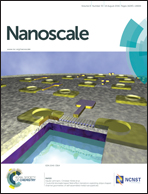Control of optical and electrical properties of nanosheets by the chemical structure of the turning point in a foldable polymer†
Abstract
Oligomers of tetra(ethylene glycol)-disubstituted phenyl-capped bithiophene (Ph2TPh) linked by catechol and resorcinol were prepared. Catechol and resorcinol link the monomers via the ortho- and meta-positions of the benzene ring, respectively, and function as turning points in the folding process of the polymer. It was confirmed that the ortho-linked 8mer (o-8mer) and meta-linked 8mer (m-8mer) could form nanosheets through the self-assembly of folded polymers in o-dichlorobenzene. We confirmed that the arrangement of thiophene units inside the nanosheets was controllable by changing the chemical structure of the turning point. The different arrangements of the Ph2TPh units led to changes in other physical properties such as UV-Vis absorption, nanosheet thickness and charge carrier transport. The absorption spectrum of the o-8mer nanosheets suggested that the Ph2TPh units are arranged vertical to the lateral direction of the nanosheets. On the other hand, the Ph2TPh units in the m-8mer nanosheets were considered to have a tilted orientation. The change in the Ph2TPh tilt angle inside the nanosheets was supported by the different thicknesses of the o-8mer and m-8mer nanosheets. The relationship between the absorption spectrum and Ph2TPh unit arrangement was discussed based on the DFT calculation. Intrinsic charge carrier transport properties were evaluated by a noncontact microwave-based method. The o-8mer nanosheets showed higher conductivity than the m-8mer and triazole-linked-8mer nanosheets. The lifetime of charge carriers in the nanosheet was longer than that in the lamellar structure of the drop-cast film.



 Please wait while we load your content...
Please wait while we load your content...